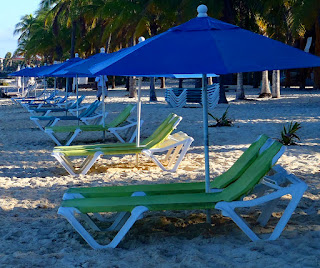Night patrols
In the blackest hours of the
night a silent intimidating figure sits on a coral outcropping at the ocean’s
edge. Cloaked in a black t-shirt, and
dark pants he patiently waits.
What’s his story?
Ernesto (Tiega) Gomez Tur has
worked for the Turtle Farm on Isla Mujeres for the last nine years, caretaking
the giant sea turtles, and their hatchlings.
Turtle season coincides with the hurricane season, May to October. Ernesto is one of the turtle farm employees patrolling
the eastern beaches late at night, waiting for returning female turtles to select
a spot to lay their eggs. It’s a quiet,
lonely job. It’s also a job that gives
him a great satisfaction. His task is to
retrieve the newly-laid eggs and transport them to the turtle farm to be hatched
out in relative safety, away from predators: birds, dogs, and humans.
 |
| Ernesto when he was about forty-two |
Born on Isla Mujeres sixty-something-years
ago, Ernesto had six brothers and four sisters most of whom are still living. Married for fifty years to Teresa Gomez
Heredia they had eight children. The
surviving seven children now have twelve offspring ranging in age from twenty
years to a few months old. Many of his two
hundred or so family members - brothers, sisters, children, grandchildren, aunts,
uncles, nieces, nephews, and cousins - frequently gather to celebrate birthdays,
weddings, Quinceaños, and other special events.
When Ernesto was a small child
he lived in centro (downtown) when there were approximately twenty families on
the island. Later when he was a young
lad he remembers helping his father farm a tract of land in Las Glorias,
growing vegetables and fruits without using any chemicals. He nostalgically speaks about the abundance
of fish, shrimp, lobsters, and conch in those years. Fishermen were able to support their families
fishing very close to home.
Unfortunately with more people, came a greater demand for seafood, and more
fishermen that have dramatically reduced the supply.
 |
| Digging out more baby turtles |
A cheerful worker, Ernesto has
had a number of jobs over the years including operating a small boat between
one of the local hotels, and the mainland: delivering hotel guests and transporting
supplies. With his strong singing voice
and engaging personality the hotel guests would joke that riding with Ernesto
was like being on a gondola in Venice Italy.
When I went to the turtle farm
to chat with him during his afternoon break, he was busily digging up dozens of
hatched turtles in preparation for releasing them. The nests have signage indicating the area on
the island where the eggs were found, the date the eggs were re-buried, and
species of turtle. He casually and competently
dug thorough two feet of damp sand, sorting out the broken eggs, and placing
the live babies in a big plastic bucket.
Taking up to sixty days to
hatch out the babies’ first instinct when they reach the surface is to get into
the water. They scramble over each
other. They paddle their little flippers
over the sand, trying to escape. But, Ernesto’s
big hand carefully scoops them up, adding them to the collection of three or
four thousand that will be held for a few days until the next scheduled turtle
release.
 |
| Cookie bandits, and Ernesto,on right |
When I went to chat with
Ernesto, I brought a dozen large cookies with me as a thank you gift. The strange thing is – at the end of our chat
Ernesto’s co-workers had guilty grins, and cookie-crumb smiles. The bag was empty by the time Ernesto thought
to look for a cookie. He laughed, a big
smile lighting his face, joking with his cookie-stealing friends.
He’s not such an intimidating
figure after all.
Lynda and Lawrie




























